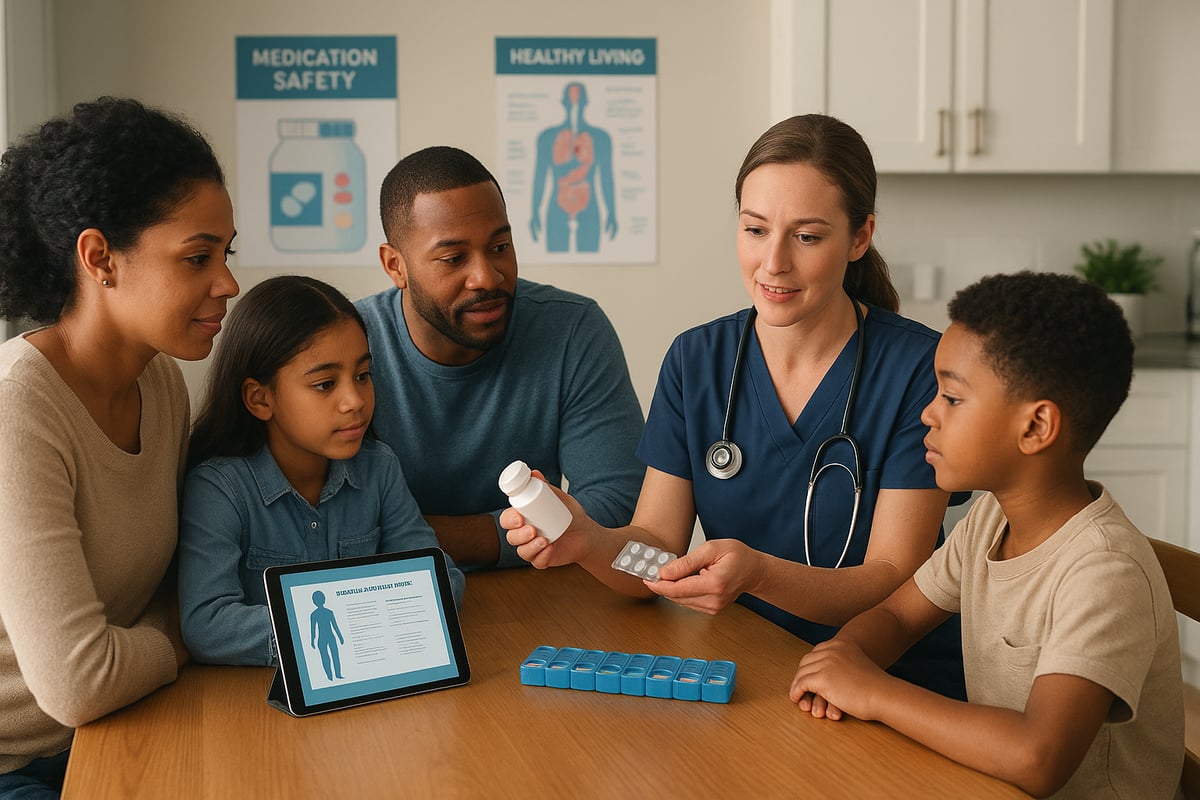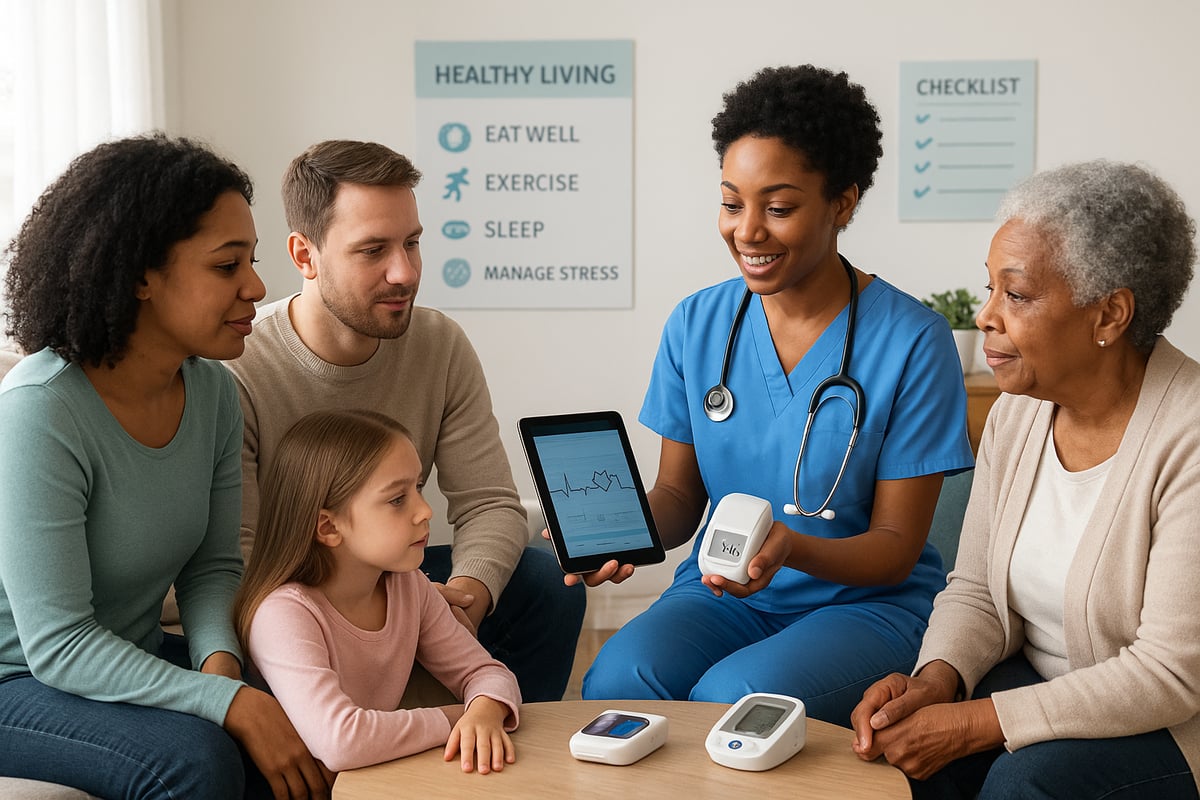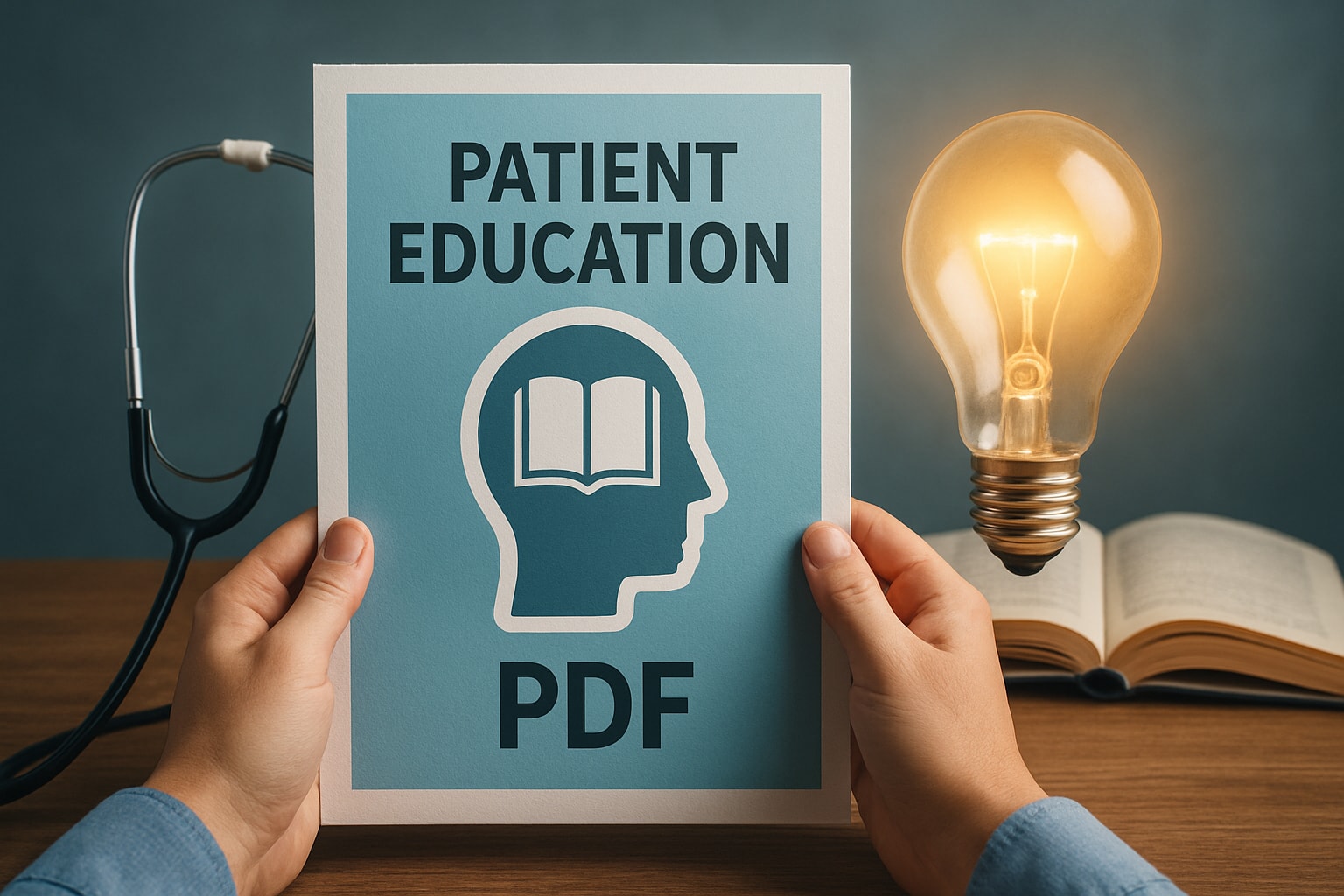Imagine a future where families confidently manage health challenges from the comfort of their own homes, making hospital visits less frequent and life more fulfilling.
As healthcare systems face growing demands, home health education becomes essential for every household. It empowers families to make informed decisions, improve daily care, and adapt to changing health needs.
This guide will help you access the latest tools, knowledge, and strategies for effective home health education in 2025. You will find practical steps, expert insights, and proven resources to take charge of your family’s well-being.
We will explore the rising importance of home health education, what makes programs effective, step-by-step empowerment strategies, the role of technology, how to overcome challenges, and what the future holds.
The Evolving Importance of Home Health Education in 2025
The landscape of healthcare is transforming rapidly as we approach 2025. Home health education has become a cornerstone in supporting families to manage health challenges outside the hospital. Several factors drive this shift, including an aging population, the rising prevalence of chronic diseases, and increasing healthcare costs. These pressures create a critical need for families to gain the skills and confidence required to care for loved ones at home.
A recent focus on proactive care has demonstrated measurable benefits. For example, nurse-led home health education programs have been shown to reduce hospital admissions and emergency visits for chronic patients. According to a study on the effectiveness of home health monitoring programs, patients who received structured education and monitoring experienced fewer acute health crises. This evidence highlights the practical value of empowering families with home health education.
The COVID-19 pandemic further accelerated the adoption of remote care. Telemedicine and digital tools became essential, making home health education more accessible than ever before. Families learned to use virtual visits, online resources, and mobile apps to stay connected with healthcare providers. These changes are now embedded in national and regional health strategies, with governments investing in programs that support family-centered education at home.
Families are increasingly recognized as primary caregivers. They are expected to manage chronic illnesses, medication regimens, and acute health events within the home environment. This shift brings both new opportunities and responsibilities. Home health education not only prepares families for these roles but also improves patient outcomes, reduces unnecessary healthcare utilization, and enhances independence and quality of life for all household members.
Consider the example of Spain’s La Ribera Health Department. By implementing a nurse-led home visit program focused on education and support, the region achieved a notable reduction in emergency department visits and hospital admissions. This model demonstrates how comprehensive home health education can lead to tangible improvements in community health.
Despite these advances, challenges remain. Access to quality home health education varies widely by region and demographic group. Differences in health literacy, language, and available support can impact a family's ability to benefit fully from these programs. Addressing these disparities is essential for ensuring that every family, regardless of background, can access the tools and knowledge needed for effective home-based care.
In summary, home health education in 2025 is more important than ever. It responds to the evolving needs of patients, families, and healthcare systems alike. By embracing innovative approaches and addressing persistent challenges, we can build a future where families are truly empowered to take charge of health at home.

Core Components of an Effective Home Health Education Program
Empowering families through home health education requires a thoughtful, holistic approach. The most effective programs blend personalized learning with practical skills, expert guidance, and emotional support. By understanding the unique needs of each household, families can build confidence in managing health at home.

Personalized Education for Every Family
No two families are the same, so home health education must be tailored to individual circumstances. This involves assessing the patient’s age, health conditions, literacy level, and cultural background. Effective programs use a combination of visual aids, interactive sessions, and easy-to-understand materials. By focusing on specific needs, families are more likely to absorb and apply key lessons.
- Assess family health goals and priorities.
- Choose formats that match learning preferences.
- Adapt materials for language and accessibility.
A Multidisciplinary Team Approach
A strong home health education program brings together professionals from different fields. Nurses, physicians, pharmacists, and social workers each offer unique expertise. This collaboration ensures families receive comprehensive guidance, from medication safety to emotional support.
- Nurses lead hands-on training and home visits.
- Physicians explain diagnoses and treatment plans.
- Pharmacists clarify medication use and interactions.
- Social workers connect families with community resources.
Building Health Literacy
Understanding medical information is essential for effective home health education. Programs should use plain language, visual aids, and repetition to reinforce key points. Teach-back methods, where families explain concepts in their own words, help confirm comprehension.
- Simplify medical jargon and instructions.
- Use infographics, charts, and checklists.
- Encourage questions and open dialogue.
Families who develop strong health literacy are better equipped to manage daily care and respond to changes in health status.
Medication and Chronic Disease Management
Safe medication practices are a cornerstone of home health education. Families learn how to store medicines, track doses, and recognize side effects. Managing chronic diseases, such as diabetes or heart failure, requires ongoing education about symptoms, prevention, and when to seek help.
- Review medication lists and create reminders.
- Teach monitoring techniques for blood sugar or blood pressure.
- Provide action plans for exacerbations or emergencies.
A focus on chronic disease management helps reduce hospital visits and supports independence.
Preventive Care and Emotional Support
Prevention is vital in home health education. Teaching families about nutrition, exercise, infection control, and fall prevention lowers health risks. Visual tools, such as those found in All About Infection Control, can make these concepts more accessible. Emotional well-being is equally important, addressing caregiver stress and connecting families to mental health resources.
- Share tips for healthy meal planning and safe physical activity.
- Highlight hygiene practices and environmental safety.
- Offer guidance on stress management and community support.
By combining preventive care and emotional support, families build resilience and long-term wellness.
Integrated Assessments and Ongoing Support
Effective home health education programs often combine health assessments, practical instruction, and psychosocial support. For example, nurse-led home visits that include both medical education and emotional check-ins have been shown to reduce hospitalizations. Regular follow-ups and adaptable resources keep families engaged and confident in their care journey.
By embracing these core components, families can fully benefit from home health education, leading to better outcomes and an improved quality of life.
Step-by-Step Guide to Empowering Families Through Home Health Education
Empowering families with home health education requires a thoughtful, structured approach. By breaking the journey into clear steps, families can build confidence, develop essential skills, and create an environment where health thrives at home.

Step 1: Assess Family Needs and Readiness
The first step in home health education is to assess the unique needs and readiness of each family. Begin by evaluating health literacy levels and existing caregiving skills. This helps tailor the approach to ensure everyone understands the information provided.
Identify chronic conditions, potential risk factors, and the caregiving capacity within the home. Use standardized assessment tools, such as Clinical Risk Groups, to stratify patient complexity and needs. Involve all family members in this process, as each person may play a different role in managing care.
Address language, cultural, and accessibility barriers to ensure equity in learning. Setting realistic goals for home health management creates a shared vision for progress. This foundation supports the effectiveness of every subsequent step in the home health education process.
Step 2: Develop a Customized Education Plan
Once needs are identified, collaborate with healthcare professionals to craft a personalized home health education plan. Prioritize topics most relevant to the family’s situation, such as medication management, symptom monitoring, nutrition, or emergency response.
Integrate multimedia resources into the plan. Use videos, printed guides, and digital apps to cater to different learning preferences. Schedule regular education sessions, which may be in-person, virtual, or a hybrid of both, to reinforce knowledge over time.
Set clear milestones and measurable outcomes for each phase. This structured approach helps families track progress and ensures all critical areas of home health education are addressed. Regularly review and adjust the plan as family needs evolve.
Step 3: Deliver Education Using Best Practices
Effective delivery of home health education relies on clear communication and hands-on learning. Use plain language and visual aids to make complex medical concepts easy to understand. Demonstrate essential skills, such as wound care or insulin administration, through hands-on practice.
Employ teach-back methods, where family members repeat instructions in their own words, to confirm understanding. Encourage active participation by inviting questions and fostering open dialogue. Provide practical tools like checklists, diaries, and reminder cards to support daily routines.
Visual aids can be especially powerful. Consider using Health Education Poster Resources to reinforce key messages and make information accessible at a glance. Practical education during home visits has shown to improve adherence and reduce emergency visits, making this step critical for success.
Step 4: Integrate Technology and Digital Tools
Technology is transforming home health education, making learning more interactive and accessible. Introduce telehealth platforms for remote consultations and follow-up appointments. Recommend health apps that offer medication tracking, symptom monitoring, and appointment reminders.
Encourage the use of wearable devices, such as glucose monitors or smart blood pressure cuffs, to collect real-time health data. This empowers families to monitor progress and respond to changes promptly. Always ensure privacy and data security when sharing sensitive health information digitally.
Telemonitoring programs led by healthcare professionals have demonstrated reductions in hospital readmissions for chronic patients. By embracing these digital tools, families can enhance their home health education experience and stay connected with their care team.
Step 5: Foster Ongoing Support and Community Connections
Sustaining home health education requires continuous support and strong community ties. Establish peer support groups, either online or within the local community, to share experiences and advice. Connect families to community health resources and social services for additional guidance.
Schedule periodic check-ins with healthcare providers to review progress and address new challenges. Encourage participation in educational workshops and webinars to keep knowledge up to date. Address caregiver burnout by providing access to mental health resources and respite care options.
Community nurse programs that blend medical, emotional, and social support have been shown to boost family resilience. By building a strong support network and staying engaged, families can maintain long-term success in home health education and confidently manage evolving health needs.
Leveraging Technology for Home Health Education in 2025
Technology is transforming home health education, making it more accessible, interactive, and effective for families everywhere. In 2025, digital tools and smart devices are not just add-ons, but essential components for empowering families to confidently manage health at home.

The Rise of Telemedicine in Home Health Education
Telemedicine has become a cornerstone of home health education. Virtual visits with healthcare professionals allow families to receive expert guidance without leaving home. Through secure video calls, families can ask questions, review care plans, and get real-time feedback on self-care techniques.
Remote monitoring tools further enhance care by transmitting health data directly to providers. For example, a nurse can review a patient's blood pressure readings from afar and adjust recommendations instantly. This immediate support reduces travel, lowers costs, and keeps families engaged in their home health education journey.
Health Apps and Digital Platforms Empowering Families
Health apps play a vital role in home health education by offering resources that are easy to access and understand. Families can use apps to track medications, log symptoms, and receive tailored health tips. Many platforms feature educational videos, interactive quizzes, and reminders to promote daily adherence.
These digital solutions help families stay organized and proactive. Some apps allow direct communication with healthcare teams, making it easier to clarify doubts or report changes in condition. As a result, families feel more confident and in control of their health routines.
Artificial Intelligence: Personalized Home Health Support
Artificial intelligence is reshaping home health education by delivering personalized support. AI-powered chatbots answer common health questions around the clock, providing quick, reliable information. Advanced systems analyze user data to offer timely reminders, medication alerts, or even detect potential health risks.
AI can also adapt educational content based on individual learning styles or health needs. For instance, a family managing diabetes might receive custom meal plans and exercise suggestions. This level of personalization makes home health education more relevant and actionable.
Wearables and Smart Home Devices for Daily Care
Wearable devices and smart home technology are now integral to effective home health education. Devices like smartwatches, glucose monitors, and blood pressure cuffs collect valuable health data in real time. These tools alert families to unusual readings and prompt timely interventions.
Smart home systems can detect falls, monitor movement patterns, or send emergency alerts if needed. By integrating these devices, families gain peace of mind and maintain independence, all while participating actively in their home health education.
Data Security and Accessibility in Home Health Education
With the growth of digital tools, protecting sensitive health information is more important than ever. Home health education platforms prioritize secure logins, encrypted communications, and strict privacy controls. Families should choose services that comply with recognized health data standards.
Accessibility is also a focus for 2025. Many platforms offer user-friendly interfaces, voice commands, and multilingual support. This ensures that home health education reaches families from diverse backgrounds, regardless of technical skill or language.
Real-World Impact and Future Innovations
The real-world impact of technology in home health education is clear. Telemonitoring programs led by primary care nurses have significantly reduced emergency department visits for chronic patients. As we look ahead, the integration of artificial intelligence and the Internet of Things will drive even more proactive, predictive care for families.
To stay updated on the latest advancements, explore Healthcare technology trends for 2025, which highlights key innovations shaping the future of home health education. By embracing these tools, families can navigate health challenges with greater confidence, independence, and success.
Overcoming Common Challenges in Home Health Education
Families striving to master home health education often encounter a range of obstacles. These challenges can limit the effectiveness of learning and impact the overall quality of care at home. Understanding and addressing these barriers is essential for building confidence, competence, and resilience in every household.
Common Barriers and Solutions in Home Health Education
| Challenge | Solution Example |
|---|---|
| Health literacy gaps | Use plain language, visual aids, and teach-back methods |
| Technology limitations | Offer printed resources, phone support, and loaner devices |
| Motivation/engagement | Create interactive sessions and peer support groups |
| Cultural/language needs | Provide materials in multiple languages, respect traditions |
| Caregiver stress | Connect to respite care and mental health services |
| Coordination issues | Schedule regular check-ins with care teams |
Low health literacy remains one of the most significant barriers to effective home health education. Many families struggle to interpret medical jargon, understand care instructions, or manage chronic conditions confidently. Using simple language, visual demonstrations, and hands-on practice can dramatically improve understanding. When addressing specific care needs such as wound management, families benefit from practical resources like the Home Health Care Wound Care Guide, which offers step-by-step instructions and clear visuals.
Another challenge is unequal access to technology. Not all households have reliable internet or smart devices for remote learning or telehealth. To bridge this gap, healthcare providers can supply printed guides, offer phone consultations, or set up loaner device programs. Ensuring that home health education remains accessible regardless of digital resources is crucial for equitable care.
Maintaining motivation and engagement over time can be difficult, especially when families juggle multiple responsibilities. Interactive learning sessions, goal tracking, and peer support groups help keep families involved. Recognizing cultural backgrounds and language preferences is equally important for delivering respectful and effective home health education. Materials should be available in multiple languages, and educators must remain sensitive to family traditions and beliefs.
Caregiver burden is another pressing concern. The emotional and physical demands of caring for loved ones can lead to burnout. Providing access to respite care, counseling, and mental health support is vital. Regular check-ins with healthcare professionals, as highlighted in Improving Patient Care at Home, have been shown to increase engagement and reduce emergency visits. Policies and funding support, including navigation of insurance and community resources, further strengthen the foundation for successful home health education.
By recognizing and proactively addressing these challenges, families are better equipped to deliver safe, effective care at home. The right resources, support, and strategies make home health education not just possible, but empowering for every household.
Future Trends and Innovations in Home Health Education
The landscape of home health education is rapidly evolving as families, providers, and policymakers embrace new models and technologies. In 2025, the shift toward hybrid care models is bringing together the best of in-person and virtual learning. Families now have access to both face-to-face guidance and digital resources, making home health education more flexible and responsive to their unique needs.
Interactive learning is also gaining ground. Gamification, including quizzes, simulations, and rewards, is making home health education engaging for all ages. These tools transform complex health topics into practical, memorable lessons. Families are motivated to participate and reinforce their knowledge, leading to better health outcomes and increased confidence in managing care at home.
Artificial intelligence is set to revolutionize home health education in 2025. AI-driven platforms now tailor content, reminders, and support based on real-time data and user behavior. This level of personalization ensures families receive timely, relevant information to manage chronic conditions and prevent complications. To explore more on how digital transformation and AI are reshaping home health, see this overview of digital transformation in home health.
A stronger focus on preventive care is emerging in home health education. Programs are shifting from reactive responses to proactive strategies, such as early risk identification and lifestyle coaching. Partnerships among healthcare providers, technology companies, and educational publishers are expanding access to evidence-based resources. These collaborations help bridge gaps in health literacy and technology adoption.
Policy developments are also shaping the future. Governments are investing in national strategies that prioritize home health education for chronic disease management. New tools are being introduced to measure program effectiveness, patient satisfaction, and cost savings. As these innovations take hold, families will be better equipped to navigate the complexities of health management at home, ensuring ongoing progress and resilience.






